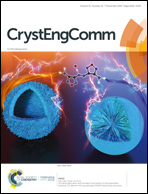Enhancing the energy barrier of dysprosium(iii) single-molecule magnets by tuning the magnetic interactions through different N-oxide bridging ligands†
Abstract
Using different N-oxide ligands to tune the Ln–Ln magnetic interactions and their magnetic relaxation behaviors, herein, three one-dimensional chain complexes, [Ln(hfac)3(4,4′BipyNO)]∞ (Ln = Dy(1), Tb(2) and Ho(3); 4,4′BipyNO = 4,4′-bipyridine-N,N′-dioxide), and three dinuclear complexes, [Ln(hfac)3(PzNO)]2 (Ln = Dy(4), Tb(5) and Ho(6); PzNO = pyrazine-N-oxide), were synthesized and characterized. The central LnIII ions of the six complexes are in an analogous LnO8 coordination environment. Magnetic investigations indicated that the chain complex 1 with negligible Dy–Dy magnetic interactions through the 4,4′BipyNO ligand and low DyIII symmetry (D2d) showed a poor slow relaxation behavior with the average energy barrier of 11.79 K under a 600 Oe dc field. However, for the complex 4, the relatively stronger Dy–Dy antiferromagnetic interactions (J = −2.36 cm−1) through the μ-O PzNO ligand combined with an improved DyIII symmetry (near D4d) significantly enhance the Ueff to 226.73 K, which records the highest Ueff for any beta-diketone constructed SMMs and also the third-highest one among all DyIII-only dimers under zero dc field to date. This study also provides another example of conspicuously improving the energy barrier of Ln-SMMs by the synergistic effect of strengthened Dy–Dy magnetic interactions and improved DyIII symmetry.



 Please wait while we load your content...
Please wait while we load your content...